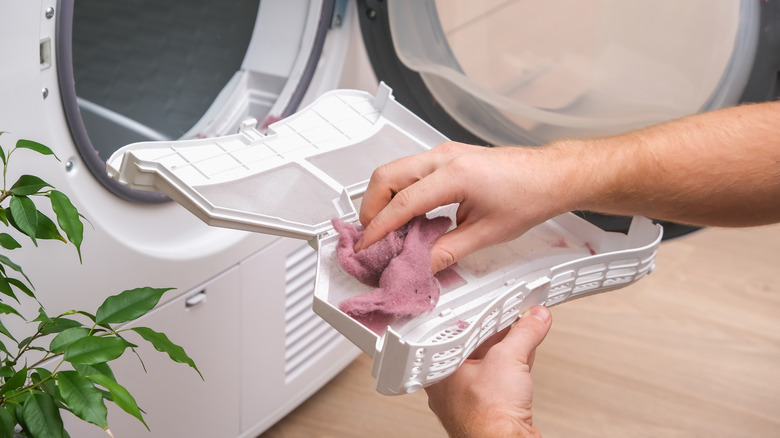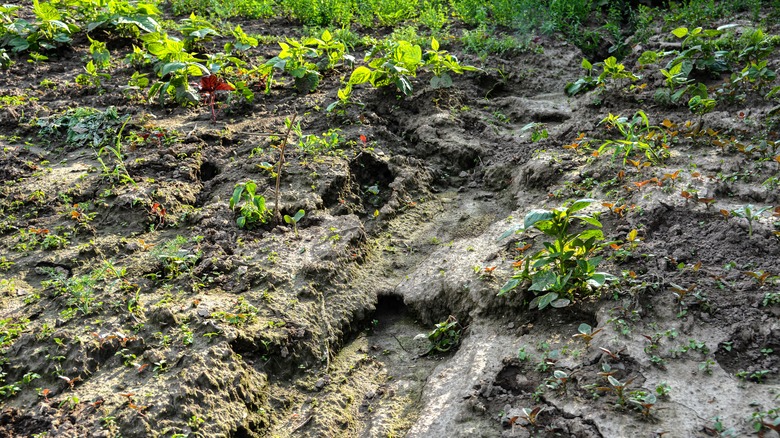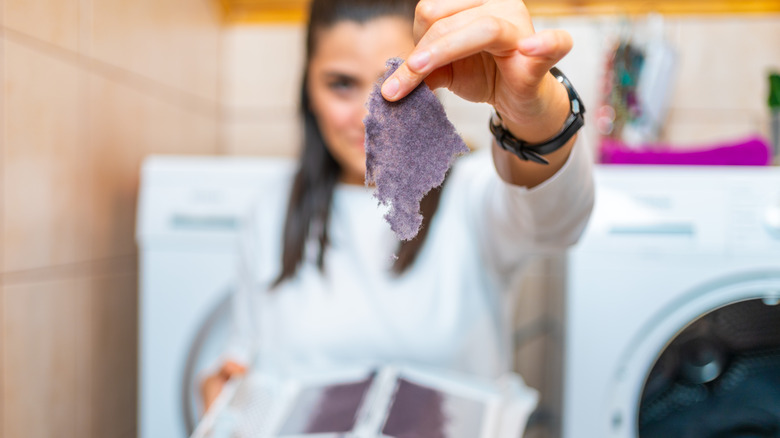The Clever Way You Can Reuse Dryer Lint To Protect Your Garden Soil From Erosion
After drying a load of laundry, the lint is often tossed in the trash can, along with the rest of your household garbage. But did you know this mixed clump of clothing fibers could actually save your garden from soil erosion? Most types of soil erosion typically happens when elements like the wind, rain, ice, and snow remove the top layer of dirt. Animals and certain gardening practices like tillage can contribute to erosion, as well, which is another reason why you might want to think twice before tilling your garden. On a grand scale, soil erosion encourages the loss of the planet's topsoil, half of which has been displaced in the last century and a half.
While your garden's topsoil may seem insignificant compared to that of the Earth, it's still important to maintain and do what you can to prevent your garden's soil from eroding. When erosion occurs, your garden may not be as fertile. Its water retention abilities will also decrease and plants may experience stunted growth. Incorporating dryer lint into your garden as a ground cover, however, can be your soil's saving grace and is why you should consider saving your dryer lint no matter how odd it sounds.
How to collect and add dryer lint to your garden to stop erosion in its tracks
Although applying dryer lint to the surface of your soil to prevent erosion may seem self-explanatory, there's a little more to the process than you might think. First, identify where in the garden you may need to apply the lint. Certain areas like slopes, hillsides, and spots that receive lots of water are typically vulnerable to soil erosion and may benefit more from the lint application.
Next, you may be wondering how much lint to collect from your dryer's lint trap. The good news is you don't have to get too specific with how much lint to use, but you do want enough to create a thick layer that will stretch across the area in which you want to prevent erosion. Next, moisten the lint with water. The weight of the water keeps the lint in place so it can act as a protective shield covering the topsoil from the elements, and may also keep weeds from sprouting. If you don't want the lint to be visible however, you can place decorative stones on top to hide it from plain sight, while adding some aesthetic charm to your garden.
The benefits of using dryer lint as a groundcover
There are plenty of ways to prevent soil erosion in your garden and using dryer lint to do so is just one of them. Therefore, a fair question to ask is how this method is a beneficial choice for preventing soil erosion in the garden? As you might guess, one of the benefits of using dryer lint to guard your soil from erosion is that it's continuously available depending on how much laundry you dry. If you need more, simply collect some after your next laundry load. This makes dryer lint a great choice for when you're in a pinch and don't have any other means to shield your soil from erosion.
Using dryer lint in this manner is also economical because it's a clever way to reuse dryer lint around your home so you don't have to go out and buy more plants to use as a groundcover, like juniper or holly fern. Additionally, dryer lint can be added to your compost, this way you're now combining two methods that prevent soil erosion. Just make sure that you can guarantee your lint doesn't include synthetic fibers from your clothes, and avoid using dryer sheets, since the chemicals from the dryer sheets can be harmful if mixed into your soil, as compost.


